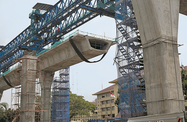Plans to upgrade Sabah's external and internal transport links are seeing progress as the state welcomes steadily increasing investment thanks to its development corridor initiative. Nevertheless, challenges remain in the shape of rival logistics destinations.
On October 19, Sabah’s chief minister, Datuk Musa Aman, revealed that RM763.7m ($249.3m) would be spent on infrastructure in 2013, with RM742.95m ($242.5m) set aside for upgrading roads and bridges, RM13.5m ($4.4m) for ports and harbours, and RM7.25m ($2.4m) for railways.
In a further boost for the sector, in November the deputy transport minister, Datuk Abdul Rahim Bakri, said that a proposed Tuaran-Kota Marudu-Kudat coastal road would bring “tremendous economic transformation” and development to north Sabah's tourism and services industries.
“A lot of benefits will come to the people in the areas concerned, in terms of greater accessibility, improved travel times and job opportunities, especially in the tourism industry, since Kudat is also located at the northernmost tip of Borneo,” he told Bernama, the Malaysian national news agency.
The Tuaran-Kota Marudu-Kudat road proposal follows confirmation a month earlier of plans to upgrade three main roads at a cost of more than RM1bn ($326.5m), with the link between Jalan Dongongon and Simpang Papar Spur improved at a cost of RM600m ($195.9m), and the Kota Kinabalu-Sindumin road to undergo widening and upgrading at a cost of RM218m ($71.2m).
In October it was also confirmed that the 2330-km Pan-Borneo Highway, which links Sabah to Sarawak and Brunei Darussalam, will undergo a major upgrade, including the mending of damaged sections and addition of overtaking lanes. Initially floated in February, it is estimated the highway upgrade will cost RM423m ($138.1m) and be funded through an initial sum of RM100m ($32.6m), shared equally between Sabah and Sarawak. In October, officials also said they planned to expand the single-lane highway to a dual carriageway by 2025.
It is hoped that such improved links will ease the price of essential goods in Sabah, which are currently higher than in Peninsular Malaysia, mainly due to higher costs of delivery and distribution in the state. To address this, as part of the national budget announced in October, the government introduced a RM386m ($125.9m) strategy – including transport subsidies – to ensure the prices of essential goods in Sabah and Sarawak, as well as in Labuan, are sold at lower prices. However, critics said the measures do not go far enough, and they sought the repeal of a cabotage policy which the business sector sees seen as the main cause of inflation.
“If the federal government can afford to subsidise the toll charges on federal highways for billions of ringgits, there's no reason why the same cannot be done for transport to Sabah as a result of the cabotage policy,” local opposition Sabah parliamentarian Chua Soon Bui said in July.
The national opposition's shadow 2013 budget, released in September, pledged “a complete and upgraded Pan-Borneo Highway” to bring development in Sabah “on a par with Peninsular Malaysia”. It also promised to assess the financial impact and viability of upgrading and extending the rail network in the state, progress on which has lagged in the past.
In 2008, plans were floated to link the east coast districts of Sandakan, Lahad Datu and Tawau to Keningau in the interior through a state-wide railway, to help ensure success of the Sabah Development Corridor (SDC), but these are yet to come to fruition.
In February last year, a 134km-section of the Sabah State Railway, formerly known as the North Borneo Railway – a joint venture between Sabah Railways Department and Sutera Harbour Resort – was re-launched after a six-year hiatus, with passengers taken from Tanjung Aru through the towns of Kinarut, Kawang and Papar to Tenom.
The state's wide-reaching transport plans will indeed likely prove key to the state's ambitions for economic growth. Since the launch of the SDC in 2008 through October 2012, Sabah had attracted planned and committed investments of RM114.04bn ($37.2bn). The chief executive officer of the Sabah Economic Development and Investment Authority (Sedia), Datuk Mohd Yaakub Johari, told local media in October that the state needed to do more to encourage growing investor interest in South-east Asia to come to Sabah.
However, the state's plans to boost its own transport connectivity face tough competition from neighbouring regions. For instance, Sarawak has approved projects worth RM27bn ($8.8bn) in 2012 in energy-intensive/heavy industries in Samalaju Industrial Park, Bintulu – a rival of Sabah's port.

